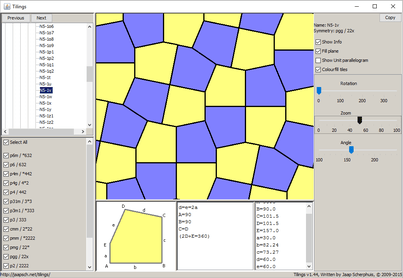
Many of the tiling patterns that I found during my research have been implemented in my Tiling Viewer. On this page are the instructions for how to install and use the program.
Downloads:
Executable jar file (1647 KB), Version 1.7
Source files (971 KB)
Send any comments or suggestions to
tilings a t jaapsch d o t net.
The Tiling Viewer can be downloaded using the links in the box on the right. It was written in java, and is an executable jar file. To run this program you need to have the Java Runtime Environment installed on your computer. This can be downloaded from Oracle's Java site. If you have that installed, just open the Tilings.jar file to start the viewer.
The Tiling Viewer was originally intended to be run in your web browser as a Java Applet. Unfortunately, most modern web browsers no longer allow this due to security concerns. If your browser still allows java applets to run, you can click this link to launch the applet in a new window. It is about 1.6 MB in size, so may take a moment to load.Version 1.0: First published online, March 2012, in time for Gathering for Gardner 10.
Version 1.1: 2012/07/22. Added filtering based on symmetry groups.
Version 1.2: 2012/11/04. Added all 2-isohedral non-convex pentagon tilings, and many non-convex hexagon tilings.
Version 1.3: 2013/07/01. Added many 3-isohedral tilings with triangles, and with pentagons.
Version 1.4: 2015/07/30. Added the 15th convex pentagon type (Mann, McLoud, Von Derau)
Version 1.42: 2015/09/29. Added info panel with current angles and side lengths.
Version 1.43: 2015/10/11. Fixed some tilings that showed incorrect angles in the info panel.
Version 1.44: 2015/12/13. Centred unit parallellogram, added missing equation to NC5-14 info.
Version 1.45: 2016/01/13. Fixed N5-8b info, and rearranged pentagon tiling menu to sort by tiling type.
Version 1.46: 2016/09/04. Added two 4-isohedral convex pentagon tilings by Dave Smith.
Version 1.47: 2016/09/05. Added two 6-isohedral convex pentagon tilings by Dave Smith.
Version 1.49: 2017/02/23. Improved Unit Parallelogram - reduce to most rectangular version, and display its stats in info window.
Version 1.491: 2017/07/06. Display more decimals in the info window.
Version 1.495: 2017/07/25. Added the 4-isohedral tiling (N5-1bf2) found in this math.stackexchange post.
Version 1.5: 2017/09/09. Instead of Copy to clipboard (did not work on all platforms), it now saves the tiling image to file in BMP, GIF, PNG, or JPG format.
Version 1.51: 2017/11/24. Subdivided the convex hexagon tilings into types in the selection tree.
Version 1.6: 2017/12/02. Added animation options, and some non-convex tilings.
Version 1.61: 2017/12/07. Small bugfix (ensure sliders are enabled after animation ends unexpectedly)
Version 1.62: 2019/05/28. Added NC5-73e, a tiling by Chirag Mehta.
Version 1.63: 2020/02/18. Added NC5-1br4 to NC5-1br10, tilings by Piet Ruhe.
Version 1.7: 2020/07/11. Support for svg images. Automatic check for updates.
Todo list:
Written by Jaap Scherphuis, tilings a t jaapsch d o t net.